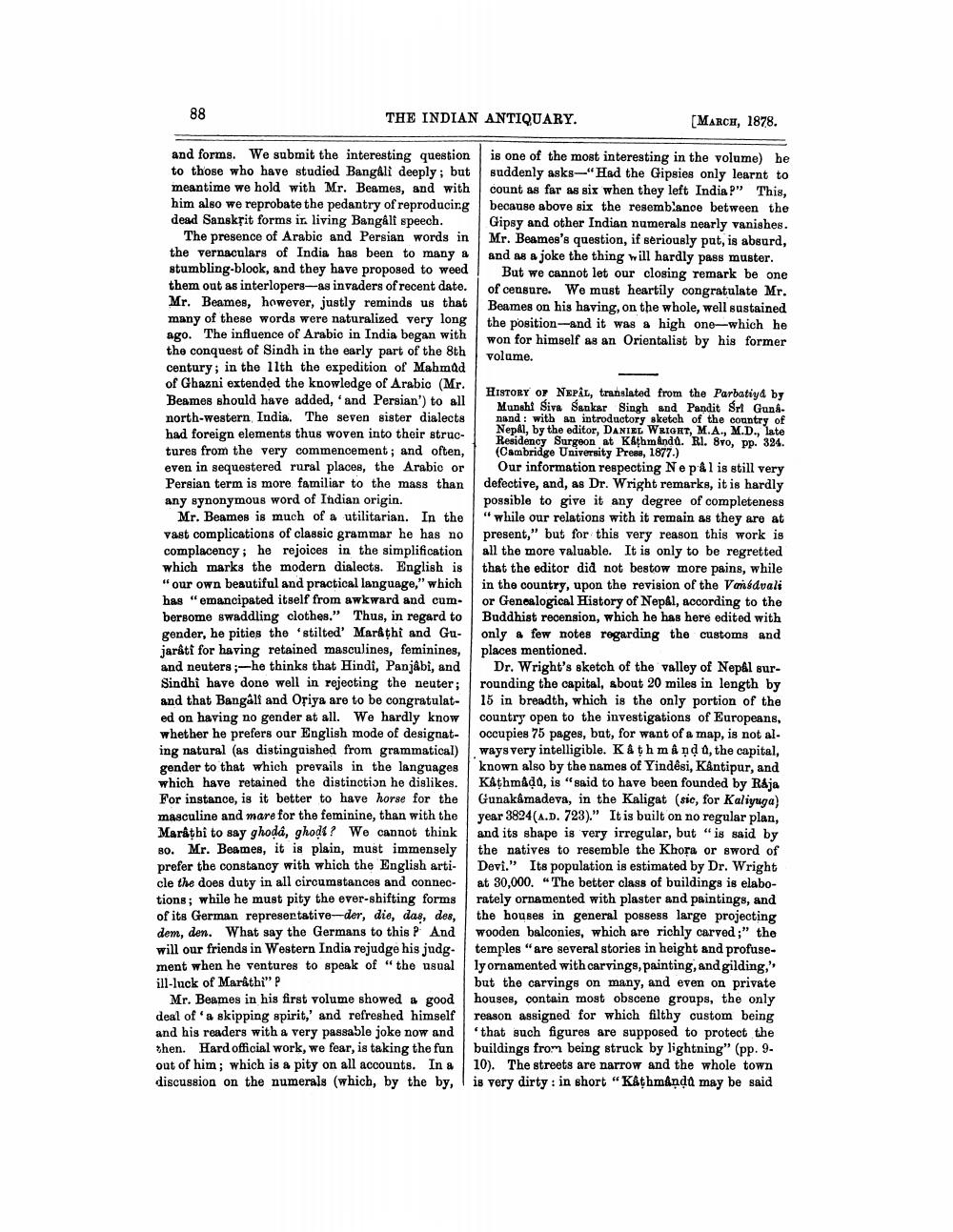________________
88
THE INDIAN ANTIQUARY.
[MARCH, 1878.
is one of the most interesting in the volume) he suddenly asks-"Had the Gipsies only learnt to count as far as six when they left India?" This, because above six the resemblance between the Gipsy and other Indian numerals nearly vanishes. Mr. Beames's question, if seriously put, is absurd, and as a joke the thing will hardly pass muster.
But we cannot let our closing remark be one of censure. We must heartily congratulate Mr. Beames on his having, on the whole, well sustained the position-and it was a high one-which he won for himself as an Orientalist by his former volume.
and forms. We submit the interesting question to those who have studied Bangali deeply; but meantime we hold with Mr. Beames, and with him also we reprobate the pedantry of reproducing dead Sanskrit forms ir. living Bangali speech.
The presence of Arabic and Persian words in the vernaculars of India has been to many a stumbling-block, and they have proposed to weed them out as interlopers-as invaders of recent date. Mr. Beames, however, justly reminds us that many of these words were naturalized very long ago. The influence of Arabic in India began with the conquest of Sindh in the early part of the 8th century; in the 11th the expedition of Mahmud of Ghazni extended the knowledge of Arabic (Mr. Beames should have added, and Persian') to all north-western, India. The seven sister dialects had foreign elements thus woven into their structures from the very commencement; and often, even in sequestered rural places, the Arabic or Persian term is more familiar to the mass than any synonymous word of Indian origin.
Mr. Beames is much of a utilitarian. In the vast complications of classic grammar he has no complacency; he rejoices in the simplification which marks the modern dialects. English is "our own beautiful and practical language," which has "emancipated itself from awkward and cumbersome swaddling clothes." Thus, in regard to gender, he pities the 'stilted' Marathi and Gujarati for having retained masculines, feminines, and neuters; he thinks that Hindi, Panjabi, and Sindhi have done well in rejecting the neuter; and that Bangali and Oriya are to be congratulated on having no gender at all. We hardly know whether he prefers our English mode of designating natural (as distinguished from grammatical) gender to that which prevails in the languages which have retained the distinction he dislikes. For instance, is it better to have horse for the masculine and mare for the feminine, than with the Marathi to say ghoda, ghoḍt? We cannot think 80. Mr. Beames, it is plain, must immensely prefer the constancy with which the English article the does duty in all circumstances and connections; while he must pity the ever-shifting forms of its German representative-der, die, das, des, dem, den. What say the Germans to this? And will our friends in Western India rejudge his judgment when he ventures to speak of "the usually ornamented with carvings, painting, and gilding," ill-luck of Marathi" P
Dr. Wright's sketch of the valley of Nepal surrounding the capital, about 20 miles in length by 15 in breadth, which is the only portion of the country open to the investigations of Europeans, occupies 75 pages, but, for want of a map, is not always very intelligible. Kathmandu, the capital, known also by the names of Yindêsi, Kantipur, and Kathmaḍa, is "said to have been founded by Raja Gunakâmadeva, in the Kaligat (sic, for Kaliyuga) year 3824 (A.D. 723)." It is built on no regular plan, and its shape is very irregular, but "is said by the natives to resemble the Khora or sword of Devi." Its population is estimated by Dr. Wright at 30,000. "The better class of buildings is elaborately ornamented with plaster and paintings, and the houses in general possess large projecting wooden balconies, which are richly carved;" the temples "are several stories in height and profuse
Mr. Beames in his first volume showed a good deal of a skipping spirit,' and refreshed himself and his readers with a very passable joke now and then. Hard official work, we fear, is taking the fun out of him; which is a pity on all accounts. In a discussion on the numerals (which, by the by,
HISTORY OF NEPAL, translated from the Parbatiya by Munshi Siva Sankar Singh and Pandit Sri Gunânand: with an introductory sketch of the country of Nepal, by the editor, DANIEL WRIGHT, M.A., M.D., late Residency Surgeon at Kathmandu. Rl. 8vo, pp. 324. (Cambridge University Press, 1877.)
Our information respecting Ne pâl is still very defective, and, as Dr. Wright remarks, it is hardly possible to give it any degree of completeness "while our relations with it remain as they are at present," but for this very reason this work is all the more valuable. It is only to be regretted that the editor did not bestow more pains, while in the country, upon the revision of the Vanédvali or Genealogical History of Nepal, according to the Buddhist recension, which he has here edited with only a few notes regarding the customs and places mentioned.
but the carvings on many, and even on private houses, contain most obscene groups, the only reason assigned for which filthy custom being 'that such figures are supposed to protect the buildings from being struck by lightning" (pp. 910). The streets are narrow and the whole town is very dirty: in short "Kathmandu may be said




